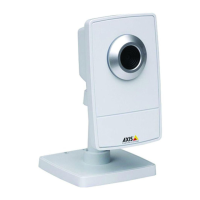
Do you have a question about the Axis M1013 and is the answer not in the manual?
| Maximum resolution | 800 x 600 pixels |
|---|---|
| Supported video modes | - |
| Camera shutter speed | 1/6 - 1/8000 s |
| Minimum illumination | 1.2 lx |
| Field of view (FOV) angle | 67 ° |
| Sensor type | CMOS |
| Progressive scan | Yes |
| Optical sensor size | 1/4 \ |
| Optical zoom | - x |
| Focus adjustment | 2.0 |
| Built-in HDD | No |
| Flash memory | 128 MB |
| Internal memory | 256 MB |
| Type | IP security camera |
| Certification | EN 55022 Class B, EN 61000-3-2, n EN 61000-3-3, EN 61000-6-1, EN 61000-6-2, EN 55024, FCC Part\\r 15 Subpart B and C Class B, VCCI Class B, C-tick AS/NZS CISPR 22, ICES-003 Class B, KCC Class B, IEC/EN 60950-1 |
| Placement supported | Indoor |
| Connectivity technology | Wired |
| Form factor | Box |
| Mounting type | Ceiling/wall |
| Product color | White |
| Housing material | Polycarbonate (PC) |
| Protection features | Dust resistant, Scratch resistant |
| Bundled software | VAPIX |
| Interface | RJ-45 |
| Ethernet LAN (RJ-45) ports | 1 |
| Cabling technology | 10/100Base-T(X) |
| Supported network protocols | IPv4/v6, HTTP, HTTPS, QoS Layer 3 DiffServ, FTP, CIFS/SMB, SMTP, Bonjour, UPnP, SNMPv1/v2c/v3(MIB-II), DNS, DynDNS, NTP, RTSP, RTP, TCP, UDP, IGMP, RTCP, ICMP, DHCP, ARP, SOCKS |
| DC output voltage | +5V |
| Power consumption (typical) | 2.2 W |
| Operating temperature (T-T) | 0 - 40 °C |
| Operating relative humidity (H-H) | 20 - 80 % |
| Depth | 95 mm |
|---|---|
| Width | 59 mm |
| Height | 41 mm |
| Weight | 110 g |
Explains danger, warning, caution levels for safety notices.
Defines levels for important and note messages.
Details physical ports and controls on the camera unit.
Explains the function of network, status, and power LEDs on the device.
Guides users on accessing the product via a web browser interface.
Explains how to make the product accessible over the internet.
Instructions for setting the initial administrator password for secure access.
Provides an overview of the live view interface and its controls.
Explains interactive elements like stream profiles and manual triggers on the live view.
Details the buttons and functions of the AMC viewer toolbar.
Details joystick, pan, tilt, and zoom controls for camera movement.
Explains H.264 streaming protocols and bandwidth considerations.
Describes the MJPEG streaming format and its characteristics.
Lists other ways to access video streams, including direct URLs.
Provides essential initial setup steps for product configuration.
Guides on configuring video stream settings like resolution and compression.
Explains how to use the pixel counter feature for image analysis.
Configuration options for image appearance, resolution, and quality.
Configuration options specific to H.264 video streams, including GOV length and profiles.
How to create, modify, and use predefined stream configurations.
Advanced settings for camera image appearance like color, sharpness, and white balance.
Setting up a specific cropped area of the camera's view for independent settings.
Adding text, date, time, or images on top of the video stream.
Process for uploading and configuring static images as overlays.
Displaying text overlays triggered by specific events or action rules.
How to mask specific parts of the video stream for privacy protection.
Selecting preferred viewers for different browsers accessing the live view.
Configuring viewer options like toolbar display and PTZ joystick mode.
Creating custom links within the live view page for scripts or web pages.
Saving camera views and setting up automated guard tours.
Configuring advanced PTZ features and shortcut command buttons.
Managing PTZ control access for multiple users through a queue system.
Setting up detection for camera tampering events like repositioning or covering.
Configuring motion detection based on defined areas and parameters.
Defining specific areas within the camera view for motion detection.
Adjusting sensitivity, object size, and history for accurate motion detection.
Defining conditions and actions for events like recording or notifications.
Configuring notification recipients for events via email, FTP, or network share.
Configuring email addresses and SMTP servers for event notifications.
Defining time-based schedules and recurring triggers for action rules.
Viewing, playing, and downloading recorded video files.
Setting up the camera to record video continuously to a storage device.
Configuring user access, ONVIF, IP filtering, and HTTPS encryption.
Setting up network access control using IEEE 802.1X authentication.
Installing and managing security certificates for the product.
Setting and synchronizing the product's date and time with NTP servers.
Configuring basic TCP/IP settings for network connectivity.
Setting up IPv4/IPv6 addresses and assigning them via ARP/Ping.
Configuring AVHS, Dynamic DNS, and DNS server settings.
Synchronizing time via NTP and enabling NAT traversal for remote access.
Configuring FTP, RTSP, SOCKS, QoS, UPnP, and RTP settings.
Managing SD card storage, including mounting and unmounting.
Procedures for formatting the SD card for use with the product.
Setting up network shares for storing recordings and data.
Performing maintenance tasks like restarting and resetting the product.
Options for factory reset and accessing support resources.
Viewing system overview, logs, and reports for analysis and troubleshooting.
Accessing advanced settings like scripting, file upload, and plain config.
Detailed steps for resetting the product to its original factory settings.
Step-by-step guide to upgrade the product's firmware.
Steps to recover the product after a failed firmware upgrade.
Addresses common problems like IP address conflicts and login failures.
Resolving issues related to video streaming, including H.264 and AXIS Media Control.
Addresses LED indicators, startup problems, image quality, and storage issues.
Details on camera model, sensor, lens, resolution, and frame rates.
Details on network security features, protocols, and encryption.
API, analytics, casing, memory, power, connectors, and operating conditions.
Product certifications, physical dimensions, weight, and included accessories.
Factors affecting performance like resolution, bandwidth, and CPU load.